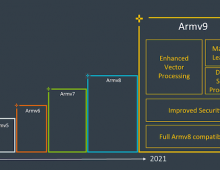
New ARM Cortex-R8 Processor Covers 5G's Need For Speed
ARM has announced the Cortex R8, a real-time CPU that offers the low latency, high performance and power efficiency demanded by future 5G modems and mass storage devices. The processor is available for licensing now and silicon is expected in 2016.
The Cortex-R8 has the same architecture to the R7 - it features an 11-stage OoO (Out-of-Order) execution pipeline and clocks of up to 1.5GHz on a 28nm HPM process. However, the new core can now be deployed as a quad-core, versus the limited dual-core configuration of the R7, doubling the theoretical processing power over its predecesssor. The cores can also be run asymetrically and also each have their own power-plane, meaning they can be turned off for power savings and increased battery life.

ARM says that a quad-core configuration on a 28nm or 16nm FinFET process being able to reach up to 15000 Dhrystone MIPS at 1.5GHz frequency.
The Cortex-R8 also enables larger tightly coupled memories (TCMs), up to 1MB of instruction TCM and 1MB of data TCM per core. In additional to other benefits the Cortex-R8 can be configured with 12, 16, 20 or 24 memory protection unit regions.
ARM silicon partners have already begun design work. SoCs based on the Cortex-R8 targeting the mass storage market segment are likely to be available in 2016. Modem designs using Cortex-R8 processors will support the rollout of the new LTE-Advanced Pro and 5G standards. The Cortex-R8 is also compatible with existing software so design cycles will be reduced, allowing developers to extend their real-time product ranges based on a single CPU architecture.
Huawei is among the first companies that have licenced the Cortex-R8.





















